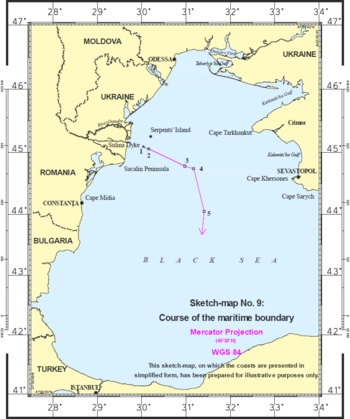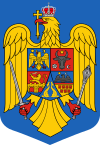| Revision as of 03:02, 3 June 2017 editInternetArchiveBot (talk | contribs)Bots, Pending changes reviewers5,387,810 edits Rescuing 3 sources and tagging 0 as dead. #IABot (v1.4beta)← Previous edit | Revision as of 22:33, 17 January 2018 edit undoInternetArchiveBot (talk | contribs)Bots, Pending changes reviewers5,387,810 edits Rescuing 2 sources and tagging 0 as dead. #IABot (v1.6.2)Next edit → | ||
| Line 20: | Line 20: | ||
| ==Judgment== | ==Judgment== | ||
| ] | ] | ||
| The court delivered its judgment on February 3, 2009,<ref>{{Cite web|url=http://www.icj-cij.org/docket/files/132/14985.pdf |
The court delivered its judgment on February 3, 2009,<ref>{{Cite web|url=http://www.icj-cij.org/docket/files/132/14985.pdf|title=The Court establishes the single maritime boundary delimiting the continental shelf and exclusive economic zones of Romania and Ukraine|accessdate=|author=|last=|first=|authorlink=|coauthors=|date=February 3, 2009|work=]|publisher=|pages=|deadurl=yes|archiveurl=https://web.archive.org/web/20090205045804/http://www.icj-cij.org/docket/files/132/14985.pdf|archivedate=February 5, 2009|df=}}</ref> dividing the Black Sea with a line between the claims of each country. On the Romanian side, the ICJ found that the landward end of the Sulina dyke (not the manmade end) should be the basis for the ]. The court noted that a dyke has a different function from a port, and only harbor works form part of the coast.<ref name="Court Judgment">{{Cite web|url=http://www.icj-cij.org/docket/files/132/14987.pdf|title=Case Concerning Maritime Delimitation in the Black Sea (Romania v. Ukraine). Judgment|accessdate=|author=|last=|first=|authorlink=|coauthors=|date=February 3, 2009|work=]|publisher=|pages=|deadurl=yes|archiveurl=https://web.archive.org/web/20150416202430/http://www.icj-cij.org/docket/files/132/14987.pdf|archivedate=April 16, 2015|df=}}</ref> | ||
| On the Ukrainian side, the court found that Snake Island did not form part of Ukraine’s coastal configuration, explaining that "to count Island as a relevant part of the coast would amount to grafting an extraneous element onto Ukraine’s coastline; the consequence would be a judicial refashioning of Geography" The court concluded that Snake Island "should have no effect on the delimitation in this case, other than that stemming from the role of the 12-nautical-mile arc of its territorial sea".<ref name="Court Judgment"/> While the judgment drew a line equitable for both parties, Romania received nearly 80 percent of the disputed area (allowing it to exploit a significant—but undetermined—portion of an estimated 100 billion cubic meters of deposits and 15 million tonnes of ] under the seabed).<ref>], February 3, 2009]</ref> However, according to UN International Court Ukrainian commissioner Volodymyr Vasylenko nearly all the oil and gas reserves are concentrated in the seabed going to Ukraine.<ref> {{webarchive|url=https://web.archive.org/web/20110716061754/http://www.interfax.com.ua/eng/main/7163/ |date=2011-07-16 }}, ] (February 3, 2009)</ref>] ] considered the ruling "just and final", hoping that it "opens new opportunities for further fruitful cooperation in all sectors of the ]".<ref> {{webarchive|url=https://web.archive.org/web/20091018083723/http://www.ukranews.com/eng/article/178853.html |date=2009-10-18 }}, ] (February 5, 2009)</ref> | On the Ukrainian side, the court found that Snake Island did not form part of Ukraine’s coastal configuration, explaining that "to count Island as a relevant part of the coast would amount to grafting an extraneous element onto Ukraine’s coastline; the consequence would be a judicial refashioning of Geography" The court concluded that Snake Island "should have no effect on the delimitation in this case, other than that stemming from the role of the 12-nautical-mile arc of its territorial sea".<ref name="Court Judgment"/> While the judgment drew a line equitable for both parties, Romania received nearly 80 percent of the disputed area (allowing it to exploit a significant—but undetermined—portion of an estimated 100 billion cubic meters of deposits and 15 million tonnes of ] under the seabed).<ref>], February 3, 2009]</ref> However, according to UN International Court Ukrainian commissioner Volodymyr Vasylenko nearly all the oil and gas reserves are concentrated in the seabed going to Ukraine.<ref> {{webarchive|url=https://web.archive.org/web/20110716061754/http://www.interfax.com.ua/eng/main/7163/ |date=2011-07-16 }}, ] (February 3, 2009)</ref>] ] considered the ruling "just and final", hoping that it "opens new opportunities for further fruitful cooperation in all sectors of the ]".<ref> {{webarchive|url=https://web.archive.org/web/20091018083723/http://www.ukranews.com/eng/article/178853.html |date=2009-10-18 }}, ] (February 5, 2009)</ref> | ||
Revision as of 22:33, 17 January 2018

Case concerning maritime delimitation in the Black Sea (Romania v Ukraine) ICJ 3 is a decision of the International Court of Justice. On September 16, 2004, Romania brought its case to the court after unsuccessful bilateral negotiations. On February 3, 2009 the court handed down its verdict, established a maritime boundary including the continental shelf and exclusive economic zones for Romania and Ukraine.
Facts
In 1997, Romania and Ukraine signed a treaty in which both states "reaffirm that the existing border between them is inviolable and therefore, they shall refrain, now and in future, from any attempt against the border, as well as from any demand, or act of, seizure and usurpation of part or all the territory of the Contracting Party". Both sides agreed that if no resolution on maritime borders could be reached within two years, either side could seek a final ruling from the International Court of Justice. Ten million tonnes of oil and a billion cubic meters of natural gas deposits were discovered under the seabed nearby.
BP and Royal Dutch/Shell signed prospect contracts with Ukraine, and Total contracted with Romania. The Austrian OMV (owner of Romania's largest oil company, Petrom) signed a contract with Naftogas of Ukraine and Chornomornaftogaz to participate in an auction of concession rights to the area.
Due to its location, Snake Island affects the maritime boundary between the two countries. If Snake Island is an island, its continental shelf area would be considered Ukrainian waters. If it is an islet, in accordance with international law the maritime boundary between Romania and Ukraine would not take it into consideration. Romania claimed that Ukraine was developing Snake Island to prove it was an island, rather than an islet.
Court hearings
On 16 September 2004 Romania brought a case against Ukraine to the International Court of Justice as part of a dispute over the maritime boundary between the two states in the Black Sea, claiming that Snake island had no socioeconomic significance. Islands are generally considered when boundaries are delimited, by the states themselves or by a third party (such as the ICJ). Depending on individual circumstances, islands may theoretically have a full, partial or no effect on determinations of entitlement to maritime areas.
However, in practice even islets are often respected in maritime delimitation. For example, Aves Island was considered in the United States – Venezuela Maritime Boundary Treaty despite its small size and the fact that it was uninhabited. Most states do not distinguish between islands and LOSC Art. 121(3) islets, claiming the shelf as an EEZ for all their islands. Examples include the UK's Rockall Island, Japan's Okinotorishima, the United States' Hawaiian Islands and a number of uninhabited islands along the equator, France's Clipperton and other islands and Norway's Jan Mayen.
Decisions by international courts, tribunals and other third-party dispute-resolution bodies have been less uniform. Although Art.121(3) rocks are taken into account when delimiting maritime boundaries, they may be overlooked, discounted or enclaved if they have an inequitable distorting effect in light of their size and location. Even if such islands are not discounted, their influence on the delimitation may be minimal. Therefore, existing decisions have not reached the level of uniformity necessary for a rule of law.
Until this dispute, there had been no third-party international review of a particular feature's status as a LOSC Art.121(3) rock or Art.121(2) island, and the ICJ's decision was difficult to predict. If it declared Snake Island an island, in delimiting the maritime zones the court could consider “special” or “relevant” circumstances (giving Snake Island full, some or no effect on the boundary). On September 19, 2008, the court closed its public hearing.
Judgment

The court delivered its judgment on February 3, 2009, dividing the Black Sea with a line between the claims of each country. On the Romanian side, the ICJ found that the landward end of the Sulina dyke (not the manmade end) should be the basis for the equidistance principle. The court noted that a dyke has a different function from a port, and only harbor works form part of the coast.
On the Ukrainian side, the court found that Snake Island did not form part of Ukraine’s coastal configuration, explaining that "to count Island as a relevant part of the coast would amount to grafting an extraneous element onto Ukraine’s coastline; the consequence would be a judicial refashioning of Geography" The court concluded that Snake Island "should have no effect on the delimitation in this case, other than that stemming from the role of the 12-nautical-mile arc of its territorial sea". While the judgment drew a line equitable for both parties, Romania received nearly 80 percent of the disputed area (allowing it to exploit a significant—but undetermined—portion of an estimated 100 billion cubic meters of deposits and 15 million tonnes of petrol under the seabed). However, according to UN International Court Ukrainian commissioner Volodymyr Vasylenko nearly all the oil and gas reserves are concentrated in the seabed going to Ukraine.Ukrainian President Viktor Yuschenko considered the ruling "just and final", hoping that it "opens new opportunities for further fruitful cooperation in all sectors of the bilateral cooperation between Ukraine and Romania".
See also
Notes
- Romania - Ukraine Treaty (1997) is available in Romanian and English in the materials submitted by Romania to the International Court of Justice , and is available in Ukrainian from the Ukrainian parliament website .
- Ruxandra Ivan (2012). New Regionalism Or No Regionalism?: Emerging Regionalism in the Black Sea Area. Ashgate Publishing, Ltd. p. 167. ISBN 978-1-4094-2213-6.
- "Romania brings a case against Ukraine to the Court in a dispute concerning the maritime boundary between the two States in the Black Sea" (PDF). International Court of Justice. September 16, 2004.
{{cite web}}: Cite has empty unknown parameter:|coauthors=(help) - "Conclusion of the public hearings - Court begins its deliberation" (PDF). International Court of Justice. September 19, 2008.
{{cite web}}: Cite has empty unknown parameter:|coauthors=(help) - "Maritime Delimitation in the Black Sea (Romania v. Ukraine)
- "The Court establishes the single maritime boundary delimiting the continental shelf and exclusive economic zones of Romania and Ukraine" (PDF). International Court of Justice. February 3, 2009. Archived from the original (PDF) on February 5, 2009.
{{cite web}}: Cite has empty unknown parameter:|coauthors=(help); Unknown parameter|deadurl=ignored (|url-status=suggested) (help) - ^ "Case Concerning Maritime Delimitation in the Black Sea (Romania v. Ukraine). Judgment" (PDF). International Court of Justice. February 3, 2009. Archived from the original (PDF) on April 16, 2015.
{{cite web}}: Cite has empty unknown parameter:|coauthors=(help); Unknown parameter|deadurl=ignored (|url-status=suggested) (help) - EU's Black Sea border set in stone, EUobserver, February 3, 2009
- Ukraine gets bulk of oil, gas reserves in delimitation dispute with Romania, says commissioner to international court Archived 2011-07-16 at the Wayback Machine, Interfax-Ukraine (February 3, 2009)
- Yuschenko: UN International Court Of Justice's Decision On Delimitation Of Black Sea Shelf Between Ukraine And Romania Just Archived 2009-10-18 at the Wayback Machine, Ukrainian News Agency (February 5, 2009)
References
- Maritime Delimitation in the Black Sea (Romania v. Ukraine): A Commentary by Alex Oude Elferink, 27 Mar 2009, The Hague Justice Portal
- Coalter G. Lathrop (July 22, 2009) "Maritime Delimitation in the Black Sea (Romania v. Ukraine)". American Journal of International Law, Vol. 103. SSRN 1470697
- Clive Schofield (2012). "Islands or Rocks, Is that the Real Question? The Treatment of Islands in the Delimitation of Maritime Boundaries". The Law of the Sea Convention: US Accession and Globalization. Martinus Nijhoff Publishers. pp. 322–340. ISBN 978-90-04-20136-1.
{{cite book}}: Unknown parameter|editors=ignored (|editor=suggested) (help)
| Africa |  | |
|---|---|---|
| Americas | ||
| Asia | ||
| Europe |
| |
| Oceania | ||
| Multilateral relations | ||
| Disputes | ||
| Diplomatic missions | ||
| Africa |  | |
|---|---|---|
| Americas | ||
| Asia | ||
| Europe | ||
| Oceania | ||
| Former countries | ||
| Multilateral relations | ||
| Diplomatic missions | ||
- International Court of Justice cases
- Territorial disputes of Ukraine
- Disputed waters
- History of the foreign relations of Romania
- Territorial disputes of Romania
- Maritime history of Romania
- Romania–Ukraine border
- 2009 in international relations
- 2009 in case law
- 2009 in Romania
- 2009 in Ukraine
- History of the Black Sea